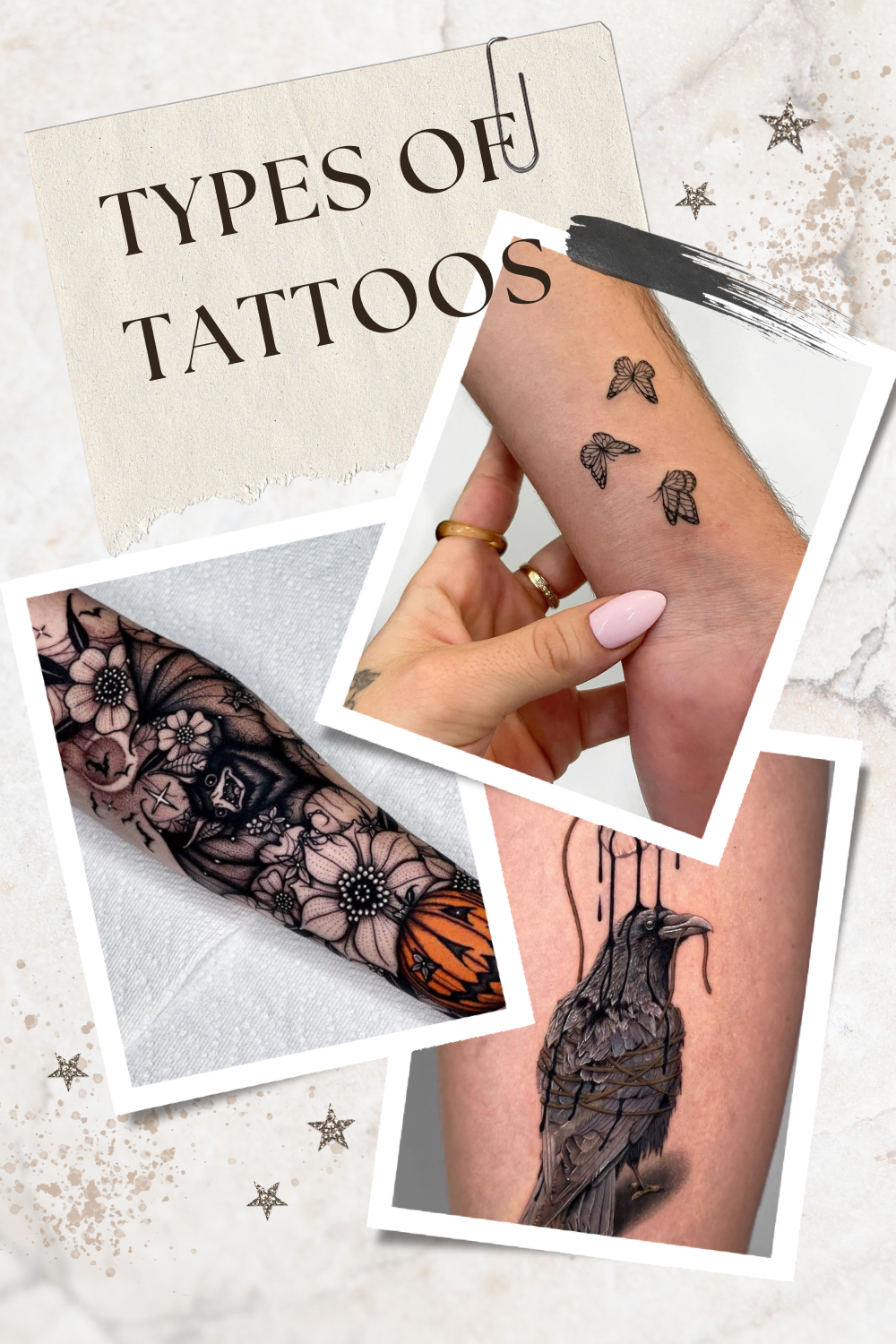Tattoos have evolved significantly over the years, with a plethora of styles emerging to cater to diverse aesthetic preferences and cultural influences. This guide explores some of the most popular Types of Tattoos, detailing their origins, characteristics, and unique features.
Table of Contents
Choosing From Various Types of Tattoos
Choosing a tattoo style can be overwhelming, but considering these factors can help:
- Personal Meaning: Reflect on what you want your tattoo to symbolize or represent.
- Style Preference: Research different styles (e.g., traditional, realism, watercolor) to see which appeals to you visually.
- Artist Specialization: Find an artist whose work you admire, especially if they specialize in a particular style.
- Placement: Consider where on your body you want the tattoo and how the style fits that area.
- Color vs. Black and Gray: Decide if you want a colorful design or something more monochromatic.
- Longevity: Some styles, like fine lines or watercolor, may fade differently over time.
- Budget: Different styles and the complexity of the design can affect the cost.
- Inspiration and Trends: Look at tattoo portfolios and current trends, but choose something timeless for you.
1. Traditional (Old School) Tattoos
Traditional tattoos, also known as Old School tattoos, have their roots in the early 20th century. This style is heavily influenced by American sailor culture, which itself drew from various global tattooing traditions encountered by sailors on their travels. The popularization of these tattoos can be largely attributed to the need for sailors to express their identities, commemorate their voyages, and display symbols of good luck and protection.
Characteristics:
- Bold Black Outlines: Traditional tattoos are characterized by their thick, bold black outlines. These lines are essential in making the designs durable and ensuring they age well over time.
- Limited Color Palettes: The color schemes in traditional tattoos are often limited and vivid, primarily featuring red, green, yellow, and blue. This limited palette was due in part to the availability of pigments and the need for colors that would remain vibrant as the tattoo aged.
- Iconic Imagery: Common motifs include anchors, swallows, roses, daggers, pin-up girls, ships, and nautical stars. Each image often carries specific meanings; for example, swallows symbolize safe returns home, while anchors represent stability and strong foundations.
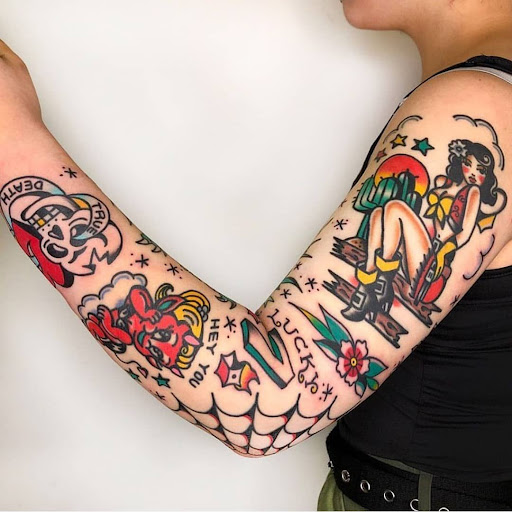
Notable Artists:
- Sailor Jerry (Norman Collins): One of the most influential figures in traditional tattooing, Sailor Jerry is known for his innovative techniques and iconic designs that remain popular today. His work set a high standard for quality and creativity in the tattoo industry.
- Don Ed Hardy: A student of Sailor Jerry, Don Ed Hardy expanded on the traditional style, incorporating more intricate and artistic elements into his work. He played a significant role in bringing tattoo art into the mainstream and elevating its status as a legitimate art form.
Traditional tattoos continue to be a popular choice due to their classic aesthetic, historical significance, and timeless appeal.
2. Neo-Traditional Tattoos
Neo-traditional tattoos are an evolution of traditional tattoos, blending the classic techniques of the early 20th century with modern aesthetics. This style emerged as tattoo artists sought to expand the boundaries of traditional tattoo art by incorporating contemporary influences and more complex designs. Neo-traditional tattoos retain the bold outlines and iconic imagery of their predecessors but push the artistic envelope further in terms of detail, color, and composition.
Characteristics:
- Intricate Designs: Neo-traditional tattoos are known for their more intricate and detailed designs compared to traditional tattoos. This includes more elaborate compositions and complex imagery.
- Wider Color Palette: Unlike the limited color palette of traditional tattoos, neo-traditional tattoos employ a much broader range of colors. This allows for greater depth and richness in the artwork.
- Detailed Shading: Shading in neo-traditional tattoos is more sophisticated, providing a sense of dimension and realism that enhances the overall aesthetic.
- Varied Line Thickness: While bold outlines are still a hallmark, neo-traditional tattoos also utilize varied line thickness to add detail and texture to the designs.
- Diverse Subjects: The subject matter in neo-traditional tattoos is often broader and more eclectic. Common themes include animals, nature, and mythological motifs, but the style also embraces a wide array of other themes and imagery.
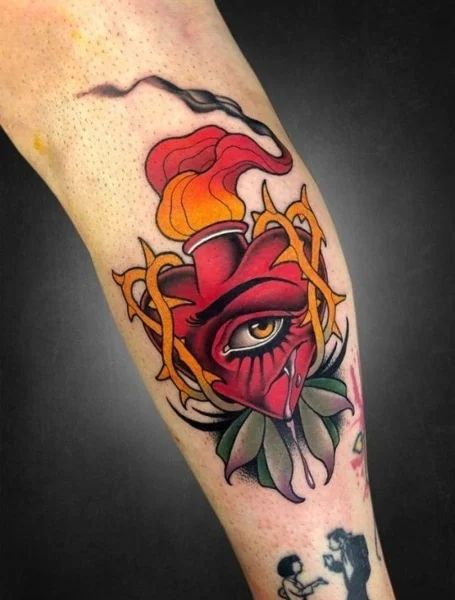
Notable Artists:
- Emily Rose Murray: Known for her stunning neo-traditional tattoos, Emily Rose Murray’s work often features dark, gothic themes, beautifully rendered with intricate detail and rich, vibrant colors.
- Russ Abbott: A prominent figure in the neo-traditional tattoo scene, Russ Abbott is celebrated for his meticulous craftsmanship and innovative designs. His tattoos often incorporate a mix of traditional and modern elements, showcasing his versatility and creativity.
Neo-traditional tattoos have gained popularity for their ability to honor the classic elements of traditional tattooing while offering a fresh, modern twist that appeals to contemporary aesthetics.
3. Realism Tattoos
Realism tattoos began gaining popularity in the late 20th century as advancements in tattoo technology and techniques allowed artists to create highly detailed and lifelike designs. Inspired by the broader art movement of realism, which seeks to depict subjects as they appear in everyday life, realism tattoos aim to replicate photographs or real-life imagery on the skin.
Characteristics:
- Highly Detailed: Realism tattoos are characterized by their incredible attention to detail. Artists strive to capture every nuance and subtle feature of the subject matter, often using fine lines and precision.
- Meticulous Shading: Shading is a crucial element in realism tattoos. Through the use of meticulous shading techniques, artists create depth, dimension, and texture, making the tattoo appear three-dimensional.
- Color Gradients: To achieve a lifelike appearance, realism tattoos often employ smooth color gradients and transitions. This technique is essential for replicating the natural variations in tone and color found in real-life subjects.
- Common Subjects: Realism tattoos frequently feature portraits (both human and animal), landscapes, and wildlife. These subjects are chosen for their ability to showcase the artist’s skill in capturing realistic detail and emotional expression.
Notable Artists:
- Nikko Hurtado: Renowned for his expertise in color realism, Nikko Hurtado is celebrated for his ability to create stunningly lifelike portraits and scenes. His work often includes celebrity portraits and complex compositions that highlight his mastery of shading and color.
- Kat Von D: A well-known figure in the tattoo world, Kat Von D has made significant contributions to the popularity of realism tattoos. Her work often focuses on black and gray realism, capturing intricate details and dramatic contrasts in her portraits and other designs.
Realism tattoos have become a popular choice for those seeking highly detailed and realistic body art. The style’s emphasis on precision and lifelike representation continues to push the boundaries of what is possible in tattoo artistry.
4. Watercolor Tattoos
Watercolor tattoos are a relatively new style that emerged in the early 21st century. This style is inspired by the techniques and aesthetics of watercolor painting, aiming to recreate the fluidity and vibrancy of watercolor artwork on the skin. As tattoo artists began to experiment with different techniques and artistic approaches, watercolor tattoos gained popularity for their unique and striking visual appeal.
Characteristics:
- Soft Edges: Unlike traditional tattoos with bold outlines, watercolor tattoos often feature soft, diffused edges. This creates a more fluid and painterly effect, mimicking the way watercolors blend on paper.
- Vibrant Colors: Watercolor tattoos are known for their bright and vivid colors. Artists use a wide range of hues to achieve the look of watercolor paint, often blending multiple colors seamlessly within a single design.
- Free-Flowing Appearance: The designs in watercolor tattoos tend to have a free-flowing and organic appearance, resembling brushstrokes and splashes of paint. This style often conveys a sense of movement and spontaneity.
- Lack of Black Outlines: Many watercolor tattoos do not use traditional black outlines, which contributes to their soft and airy look. This can make the tattoo appear more like a piece of watercolor art rather than a conventional tattoo.
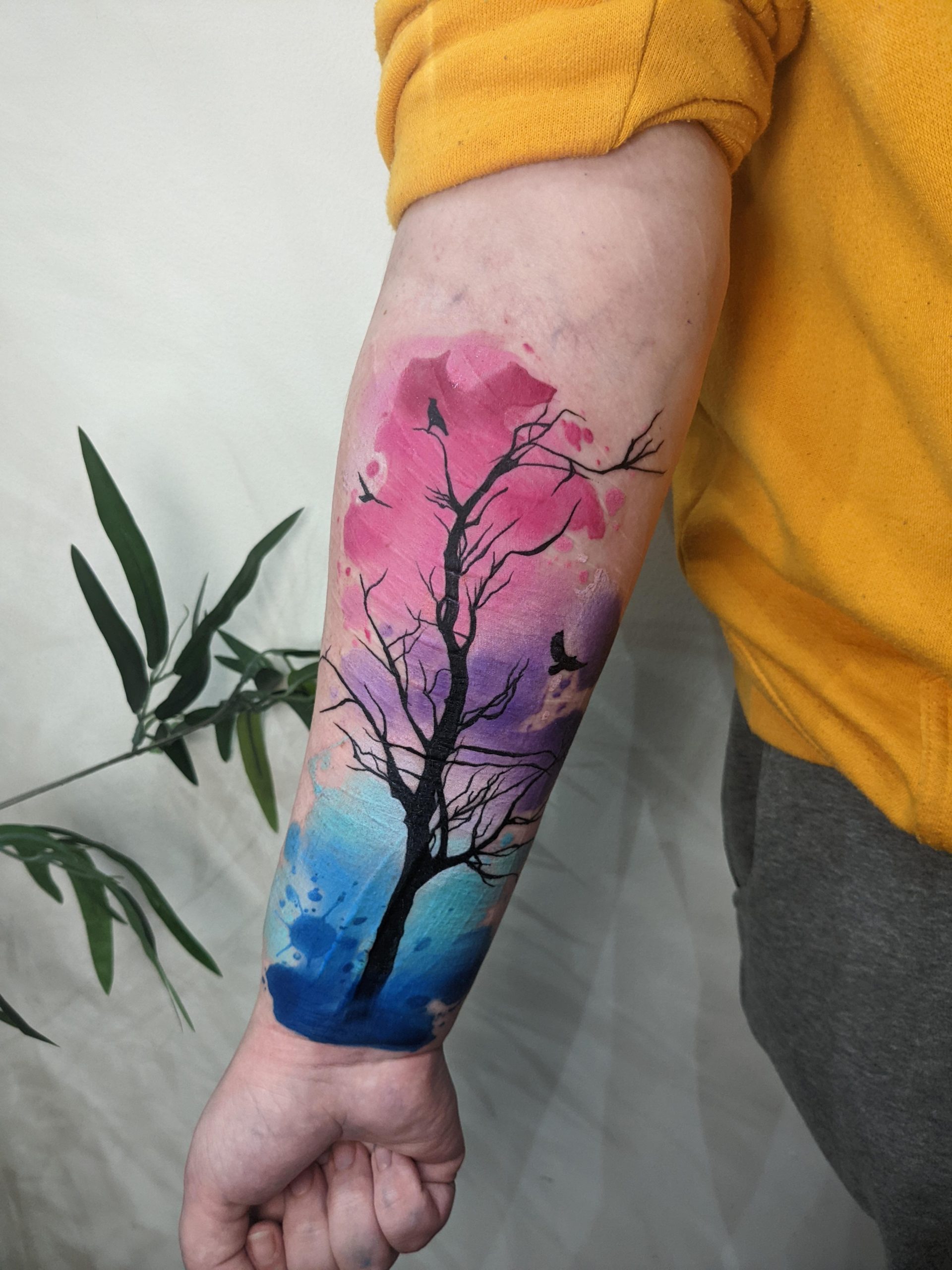
Notable Artists:
- Ondrash: A pioneer in the watercolor tattoo style, Ondrash is known for his vibrant and expressive designs that often incorporate abstract elements and bold splashes of color. His work is celebrated for its artistic quality and innovative approach.
- Amanda Wachob: Another leading figure in the watercolor tattoo movement, Amanda Wachob has gained acclaim for her ability to blend traditional tattoo techniques with fine art. Her tattoos often feature delicate washes of color and intricate, painterly details.
Watercolor tattoos offer a fresh and contemporary option for tattoo enthusiasts, providing a way to wear art that looks like it was painted directly onto the skin. This style’s emphasis on color, fluidity, and creativity continues to captivate both artists and clients alike.
5. Blackwork Tattoos
Blackwork tattoos derive from ancient tribal tattooing traditions and modern graphic design. The style has roots in various indigenous cultures around the world, where tattoos were often created using solid black ink to form intricate patterns and meaningful symbols. In contemporary times, blackwork has evolved by incorporating elements of modern graphic design, leading to a diverse range of bold and visually striking tattoos.
Characteristics:
- Solid Black Ink: The defining feature of blackwork tattoos is the use of solid black ink. These tattoos often rely on high contrast and dense black areas to create striking visuals.
- Bold, Graphic Designs: Blackwork tattoos are known for their bold and graphic nature. The designs are usually clear and impactful, often incorporating elements like thick lines, strong contrasts, and large areas of black.
- Geometric Patterns: Many blackwork tattoos feature geometric patterns, such as mandalas, tessellations, and other symmetrical designs. These patterns can be highly intricate and are often used to create a sense of harmony and balance.
- Abstract Art: Abstract designs are also common in blackwork tattoos. These can include a wide range of styles, from minimalist shapes to complex, abstract compositions.
- Tribal Motifs: Drawing on their tribal origins, many blackwork tattoos include traditional tribal motifs. These designs often carry cultural significance and can include elements like totems, animal symbols, and spiritual icons.
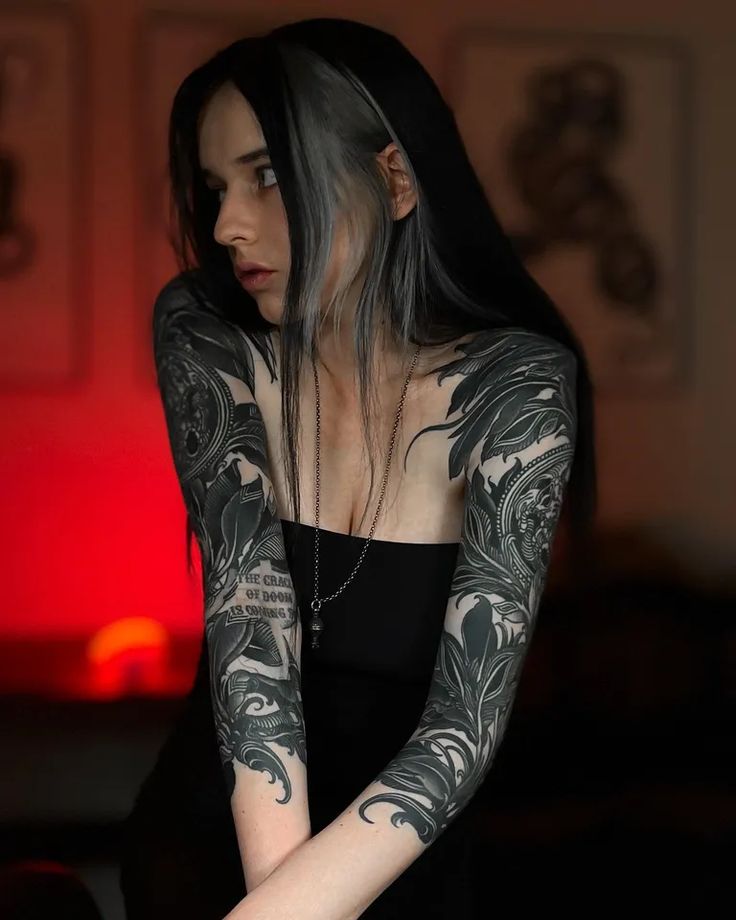
Notable Artists:
- Tomas Tomas: Known for his intricate geometric designs and mastery of the blackwork style, Tomas Tomas creates tattoos that often feature complex patterns and optical illusions. His work is celebrated for its precision and artistic depth.
- Roxx: A leading artist in the blackwork tattoo scene, Roxx is known for her bold, graphic designs and innovative approach. Her tattoos often combine tribal influences with modern aesthetics, resulting in powerful and visually stunning pieces.
Blackwork tattoos continue to be a popular choice for those seeking bold, high-contrast designs. The style’s ability to incorporate both traditional and contemporary elements allows for a wide range of artistic expression, making it a versatile and enduring tattoo genre.
6. Dotwork Tattoos
Dotwork tattoos evolved from pointillism, an art technique developed in the late 19th century where images are created using small dots of color. This meticulous method found its way into tattooing, allowing artists to create intricate and detailed designs using a series of tiny dots. Dotwork has since become a distinct and popular style within the tattooing world.
Characteristics:
- Tiny Dots: The defining feature of dotwork tattoos is the use of tiny, precise dots to form the overall design. These dots can vary in density and size to create gradients and shading, giving the tattoo depth and texture.
- Detailed Designs: Dotwork tattoos are known for their intricate and detailed patterns. The use of dots allows for fine lines and subtle variations, making it possible to achieve highly detailed and delicate designs.
- Geometric Patterns: Many dotwork tattoos feature geometric patterns, including shapes like circles, triangles, and hexagons. These patterns often create mesmerizing visual effects and can be highly symmetrical.
- Mandala Tattoos: Dotwork is commonly used in mandala tattoos, which are circular designs with intricate, repetitive patterns. The dotwork technique enhances the mandala’s complexity and beauty.
- Shading and Gradients: Dotwork tattoos often employ dots of varying densities to create shading and gradients. This technique allows for smooth transitions and a three-dimensional appearance, adding depth to the tattoo.
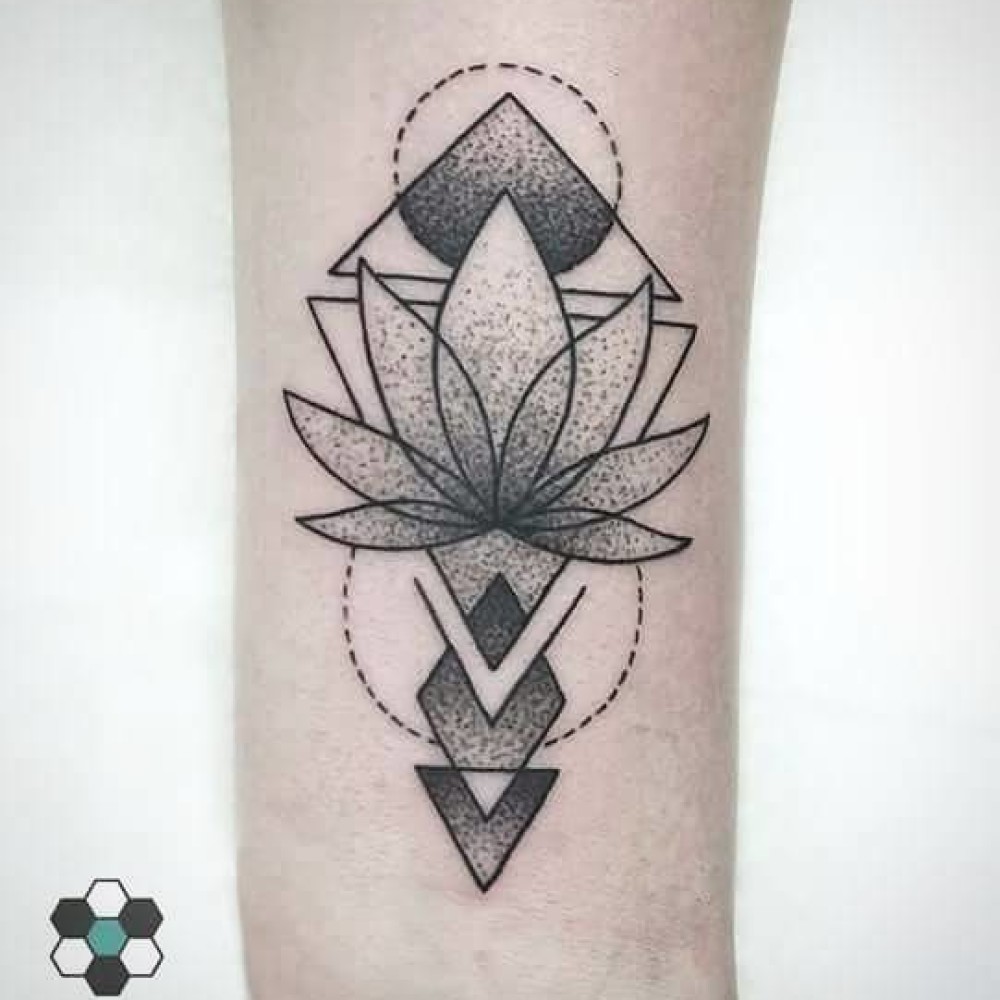
Notable Artists:
- Xoïl (Loïc Lavenu): Xoïl is a renowned dotwork tattoo artist known for his unique and avant-garde designs. His work often blends dotwork with elements of graphic design, creating tattoos that are both intricate and modern.
- Chaim Machlev (DotsToLines): Chaim Machlev, also known as DotsToLines, is famous for his geometric and minimalist dotwork tattoos. His designs often feature complex patterns and are highly precise, showcasing the beauty of the dotwork technique.
Dotwork tattoos offer a unique and visually striking option for tattoo enthusiasts, combining the precision of pointillism with the artistry of tattooing. This style’s emphasis on detail, shading, and geometric patterns continues to captivate and inspire both artists and clients.
7. Japanese (Irezumi) Tattoos
Origins: Japanese tattoos, known as Irezumi, have a rich history that dates back centuries. These tattoos have deep cultural and historical significance in Japan, often associated with mythology, folklore, and traditional art. While they were historically linked with social status and spiritual beliefs, Irezumi later became associated with the Yakuza, Japan’s organized crime syndicates, which contributed to their controversial reputation.
Characteristics:
- Bold Outlines: Irezumi tattoos are characterized by their strong, bold outlines, which help define the intricate designs and ensure the tattoos age well over time.
- Extensive Use of Color: These tattoos are renowned for their vibrant and extensive use of color. Traditional Irezumi uses a limited but vivid color palette, often featuring shades of black, red, green, and blue.
- Traditional Themes: Common themes in Irezumi include koi fish, dragons, cherry blossoms, samurai, geishas, tigers, and mythological creatures. Each motif carries specific symbolic meanings, such as strength, courage, and beauty.
- Large Body Areas: Irezumi designs typically cover large areas of the body, such as the back, chest, arms, and legs. Full-body suits or extensive sleeves are common, with the designs often flowing seamlessly across different parts of the body.
- Cultural and Mythological Elements: The designs are rich in cultural and mythological elements, often telling a story or depicting scenes from Japanese folklore and legends.
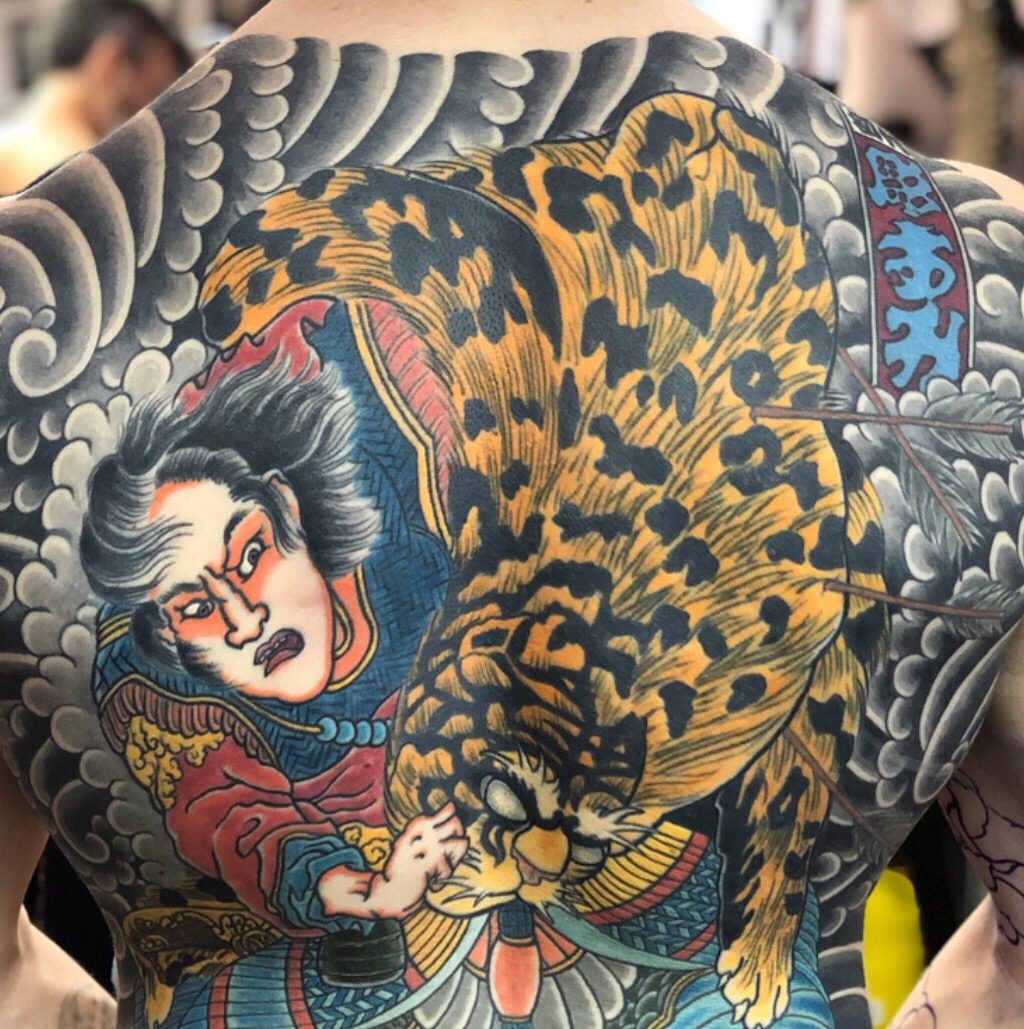
Notable Artists:
- Horiyoshi III (Yoshihito Nakano): One of the most famous Irezumi artists, Horiyoshi III is renowned for his traditional Japanese full-body tattoos. His work is highly respected for its adherence to traditional techniques and its intricate, detailed artistry.
- Shige (Shigenori Iwasaki): Shige is a celebrated tattoo artist known for his modern interpretations of traditional Japanese themes. His work often blends traditional Irezumi motifs with contemporary tattooing techniques, creating unique and dynamic designs.
Irezumi tattoos continue to be a powerful form of artistic expression, reflecting a deep cultural heritage and a commitment to the traditional craft. Despite their complex history, these tattoos are appreciated worldwide for their beauty, complexity, and profound cultural significance.
8. New School Tattoos
Origins: New School tattoos emerged in the late 20th century, influenced by graffiti art, comic book art, and animation. This style represents a departure from traditional tattooing, embracing exaggerated features, vibrant colors, and whimsical themes to create dynamic and imaginative designs.
Characteristics:
- Exaggerated Features: New School tattoos often feature exaggerated proportions and caricature-like elements. This includes oversized eyes, heads, and other body parts to create a playful and cartoonish appearance.
- Vibrant Colors: The color palette in New School tattoos is typically bright and vivid, with strong contrasts and bold shading. Colors are used to enhance the whimsical and eye-catching nature of the designs.
- Whimsical Themes: Designs in this style often incorporate imaginative and humorous themes. Common subjects include surreal creatures, fantastical landscapes, anthropomorphic characters, and playful scenes.
- Cartoon-like Aesthetic: The overall aesthetic of New School tattoos is cartoon-like, drawing inspiration from animated cartoons, comic books, and street art. This style embraces creativity and often incorporates elements of fantasy and pop culture.
- Dynamic Composition: New School tattoos feature dynamic compositions with movement and energy. Artists use perspective and design elements to create depth and visual interest.
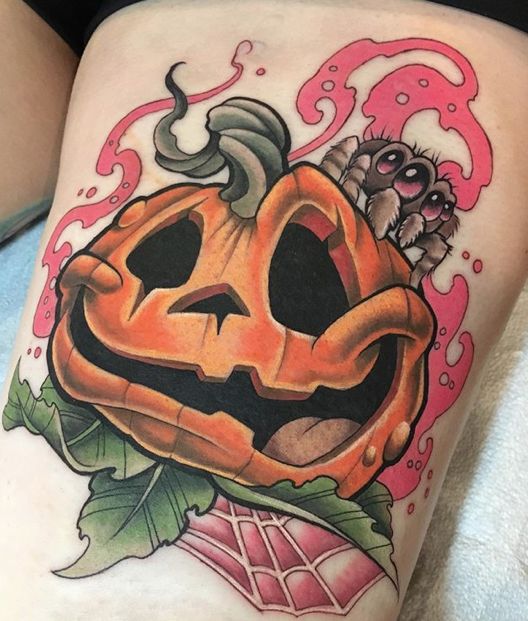
Notable Artists:
- Joe Capobianco: Known for his bold, colorful New School tattoos, Joe Capobianco’s work often incorporates elements of pin-up art and pop culture. His tattoos are characterized by their dynamic compositions and vibrant color palettes.
- Jesse Smith: A prominent figure in the New School tattoo scene, Jesse Smith is celebrated for his imaginative and surreal designs. His work combines cartoonish elements with fine art techniques, creating tattoos that are both playful and visually striking.
New School tattoos continue to evolve, pushing the boundaries of tattoo artistry with their creativity and unique aesthetic. This style appeals to those looking for tattoos that are expressive, fun, and full of personality.
9. Tribal Tattoos
Origins: Tribal tattoos are one of the oldest tattoo styles, rooted in ancient tribal traditions from various cultures around the world. These tattoos have deep cultural and spiritual significance and were historically used to signify status, achievements, and identity within tribal communities.
Characteristics:
- Bold Black Lines: Tribal tattoos are characterized by bold, black lines that create intricate patterns and designs. These lines are often thick and can be either continuous or segmented, forming geometric shapes and motifs.
- Patterns with Cultural Significance: The designs in tribal tattoos hold cultural significance and often incorporate symbols and patterns that represent specific aspects of tribal life, such as ancestry, rituals, and spirituality.
- Common Elements: Typical elements found in tribal tattoos include spirals, lines, triangles, and other symmetrical shapes. These elements are arranged in patterns that are both aesthetically pleasing and culturally meaningful.
- Minimal Use of Color: Traditional tribal tattoos are primarily done in black ink, with minimal use of other colors. The focus is on the boldness and clarity of the design rather than on color variations.
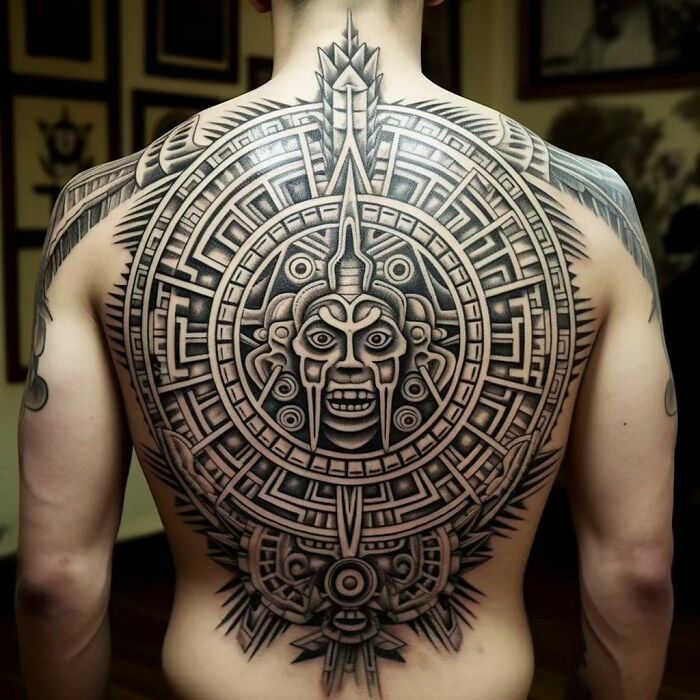
Notable Artists:
- Pat Morrow: Pat Morrow is known for his expertise in Polynesian and Maori tribal tattoo styles. His work is characterized by its authenticity and respect for traditional techniques and designs.
- Keone Nunes: Keone Nunes is a respected Hawaiian tattoo artist known for reviving traditional Hawaiian tattooing practices. He specializes in kakau (traditional Hawaiian tattooing) and has played a significant role in preserving and promoting Hawaiian cultural heritage through tattooing.
Tribal tattoos continue to be popular among those seeking to connect with ancient cultural traditions and express a sense of heritage and identity through their tattoos. While modern interpretations of tribal tattoos may incorporate contemporary influences, traditional tribal designs remain timeless symbols of cultural pride and spiritual significance.
10. Biomechanical Tattoos
Origins: Biomechanical tattoos are inspired by science fiction and the artwork of H.R. Giger, the Swiss surrealist artist known for his biomechanical designs. This style emerged in the late 20th century, blending organic elements with mechanical parts to create intricate and often surreal tattoos.
Characteristics:
- Organic and Mechanical Fusion: Biomechanical tattoos combine elements of the human body, such as muscles, bones, and skin, with mechanical components like gears, pistons, and cables. The designs give the illusion of machinery beneath the skin, merging the organic and mechanical worlds.
- Realistic Shading and Detail: Biomechanical tattoos are known for their realistic shading and intricate details. Artists use techniques such as smooth gradients, precise line work, and meticulous shading to create depth and texture, enhancing the illusion of three-dimensional machinery.
- Complex and Surreal Designs: Designs in this style are often complex and surreal, with intricate patterns and futuristic elements. Artists may incorporate biomechanical creatures, alien-like structures, and other imaginative elements inspired by science fiction.
- Dynamic and Flowing Compositions: Biomechanical tattoos often feature dynamic compositions that flow with the natural contours of the body. Artists may wrap the design around limbs or incorporate it into larger, more cohesive pieces.
- Limited Color Palette: Biomechanical tattoos typically use a limited color palette, focusing on shades of gray to create a metallic or mechanical appearance. Some designs may include subtle accents of color to add visual interest.
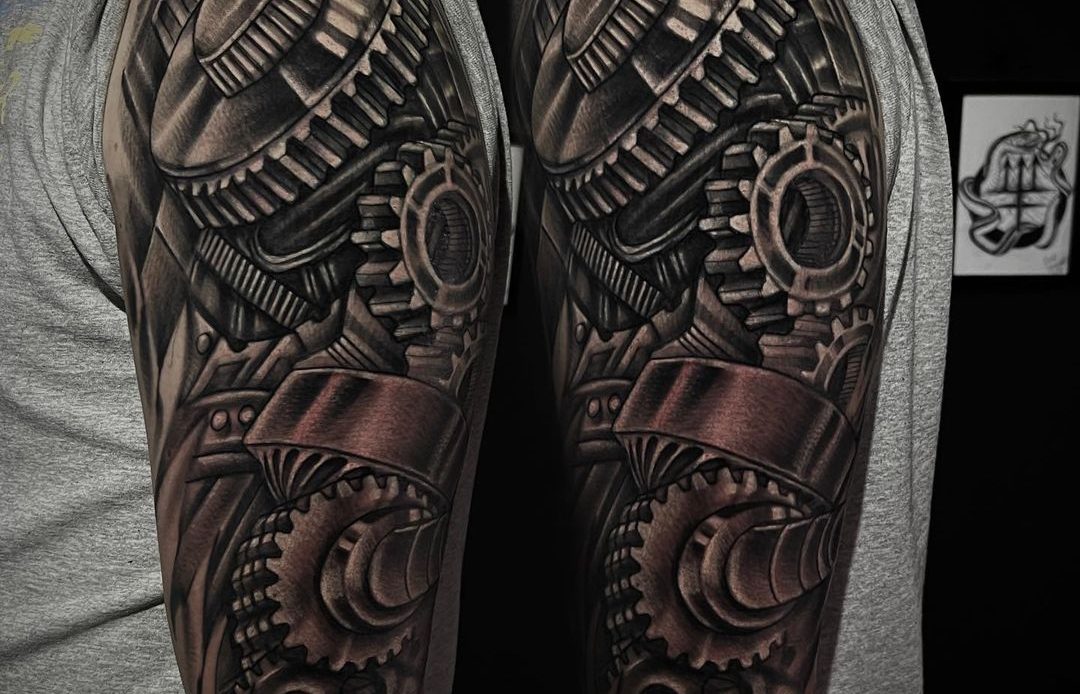
Notable Artists:
- Guy Aitchison: Guy Aitchison is a pioneer in the biomechanical tattoo style. His work is known for its incredible detail, smooth gradients, and imaginative designs that push the boundaries of tattoo artistry.
- Aaron Cain: Aaron Cain is another influential artist in the biomechanical tattoo genre. His tattoos often feature intricate mechanical details and dynamic compositions that wrap around the body, creating a seamless blend of organic and mechanical elements.
Biomechanical tattoos continue to captivate enthusiasts with their blend of artistry and science fiction. This style allows for creative expression and offers a futuristic aesthetic that appeals to those interested in exploring the boundaries of tattoo art.
11. Minimalist Tattoos
Origins: Minimalist tattoos are a modern trend that values simplicity, clean lines, and elegance in tattoo design. This style emerged as a reaction to more complex and traditional tattoo styles, focusing on minimalism and understated beauty.
Characteristics:
- Clean Lines: Minimalist tattoos are characterized by clean, crisp lines. These tattoos often feature simple geometric shapes, fine lines, and precise outlines.
- Minimal Shading: Shading in minimalist tattoos is subtle and minimal, if used at all. The emphasis is on the simplicity of the design rather than on intricate shading or color gradients.
- Small, Simple Designs: Designs in this style are typically small and straightforward. Common motifs include minimalist symbols, geometric shapes (such as triangles or circles), simple animals, and single-line drawings.
- Black Ink: Minimalist tattoos often use black ink exclusively, although some designs may incorporate small touches of color for contrast or emphasis.
- Negative Space: Negative space is sometimes used in minimalist tattoos to enhance the design’s simplicity and clarity. This technique allows the skin to become part of the design, adding depth and visual interest.

Notable Artists:
- Dr. Woo (Brian Woo): Dr. Woo is a highly respected tattoo artist known for his intricate and delicate minimalist designs. His tattoos often feature fine lines, subtle shading, and unique compositions that blend seamlessly with the body.
- Mo Ganji: Mo Ganji is known for his minimalist single-line tattoos that use continuous lines to create striking and symbolic designs. His work emphasizes simplicity and clarity, often depicting animals, faces, and abstract forms with a single unbroken line.
Minimalist tattoos have gained popularity for their ability to convey meaning and beauty through simplicity. This style appeals to those who prefer a more subtle and refined approach to tattoo art, focusing on the essence of the design rather than on elaborate details.
